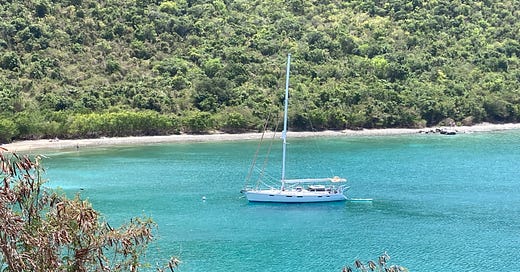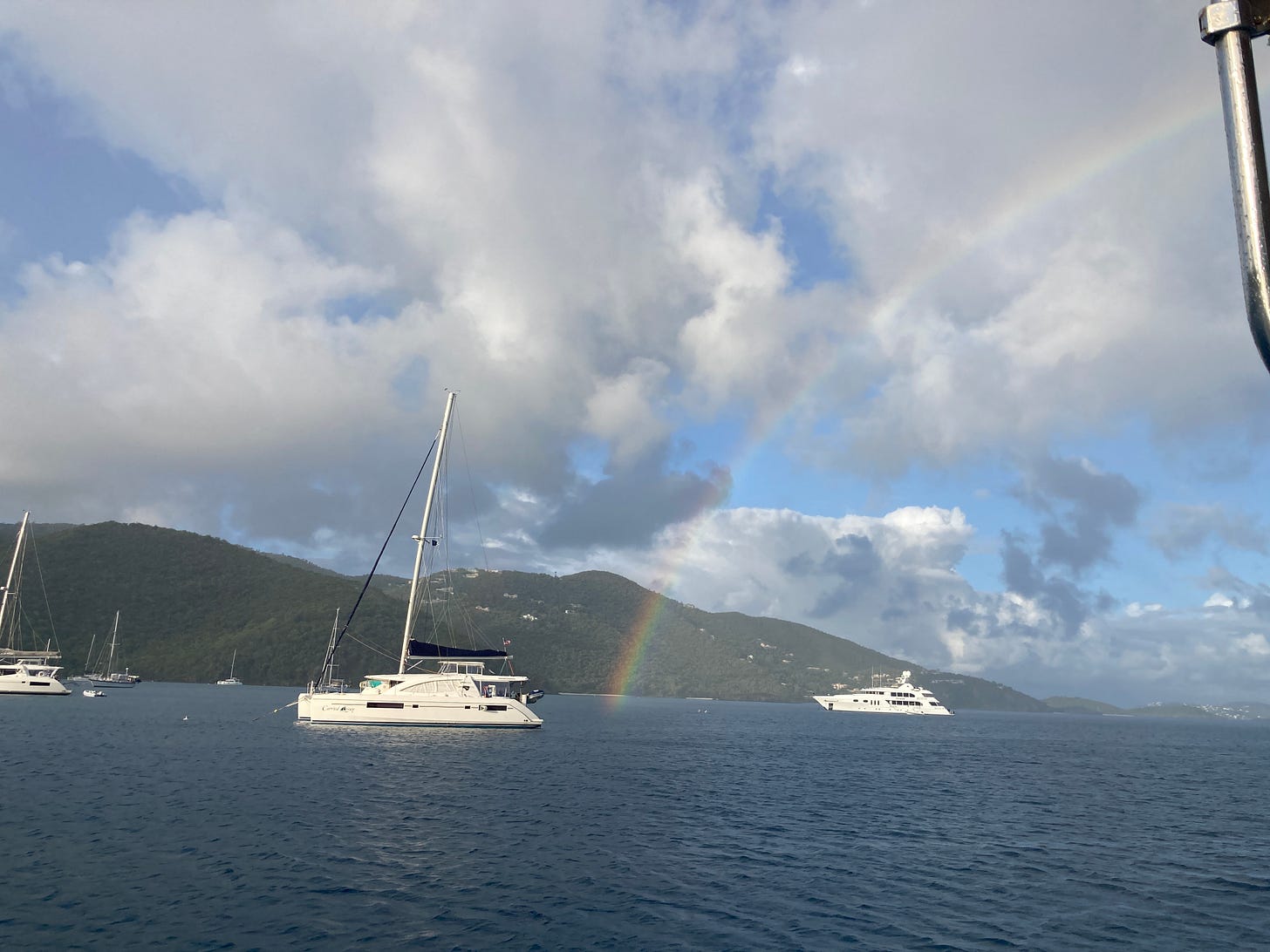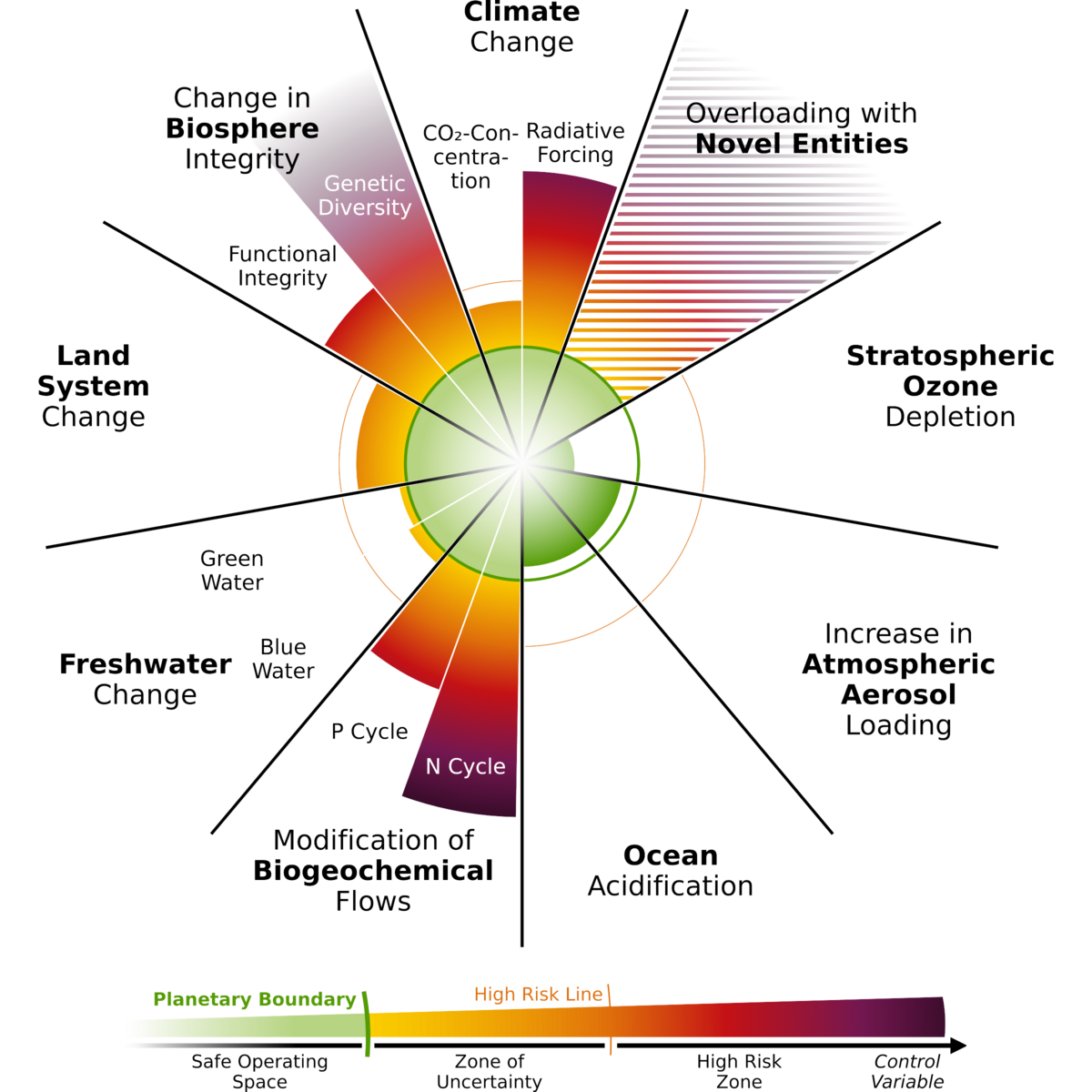Islands, Moorings And The Mad King
Reflections on a fading Caribbean season, the state of the world, and a long passage ahead
I’m in pre-passage limbo, and my moveable waterfront condo (aka Laughing Gull) has been bouncing back and forth between St. John (for rustication) and the British Virgin Islands (for fun in the sun with an old college friend aboard). Each place serves its purpose perfectly, as I prepare to cross the Atlantic. There are few better regions to spend the winter than the Caribbean, but it is well into April, which is a time of migration. There are cruisers around still, but enough have gone that I am starting to feel like a straggler at a late night party. It is time to go. I am ready to migrate.
During the BVI rotation I returned to The Bight on Norman Island for the first time in decades. I had mostly stayed away because it has become a notorious party spot for charter boats and sailing YouTubers, with a tourist trap floating bar called the Willy T, and a beach club ashore. There are close to 100 moorings in The Bight, where once there was just sand and brush. I imagined a rowdy, sloppy, floating bacchanal, which as you know by now is not exactly my thing (anymore).
The Bight had its share of partying boats, as expected. I couldn’t complain as they behaved with exactly the same lack of consideration for neighbors as my younger self did when I was cruising these same waters with friends all those years ago, making our way from anchorage to anchorage, chugging rum punch, and having a grand old time with few cares in the world. My current self would undoubtedly rate my younger self of that era with an epithet. But that is the nature of arrogant youth, when you find it hard to see beyond yourself, and are sure the world will be grateful to be introduced to your superior musical taste.
Some of the late-night boats blasted better playlists than others. But on balance I was happy to make my return The Bight, not only for nostalgia’s sake, but because I had forgotten what an absolutely excellent, well-protected anchorage it is. As a connoisseur of fine anchorages I was pleased to reacquaint myself and restore The Bight to my mental rankings, where it belongs.
Would I have prefered to be there without the bars and crowds, perhaps with just a handful of boats bobbing under full moon, the trade winds whispering, and my anchor stuck firmly in the sand, as it was in ye olden days? Of course. But I don’t have access to a time machine, and a great harbor is a great harbor. I am always happy to be in one.
You might think the moorings would also result in demerits from me, as I lament the loss of anchorages in coastal towns up and down the East Coast of the US. But down here in the Virgin Islands and beyond I have come to see their benefit. Why? Because it has become clear that they really do help protect the bottom from anchors and the scything effect of anchor chains. The result is a flourishing of underwater grasses and vegetation where previously there was no flourishing, due to the relentless scraping of anchor chain. That in turn means lots more turtles, rays, and other sea life. Seeing a sea turtle pop its head above water for a casual look around is now just part of the scenery, and can happen throughout any given day in a mooring field. In fact, I just saw three on my short paddle back to the boat following a trail run. I don’t recall ever seeing so many turtles (or rays) as I do now, and I delight in their company.
All sailors thrill to the freedom and the romance of being able to drop your hook wherever you happen to end up. But wherever coral, underwater grasses and vegetation can grow, which is to say wherever anchors can do damage, moorings are a blessing (and if the fees also go toward protecting the ecosystem, even better). I wish the cruising community would stop freaking out, and accusing local governments of corruption, every time new moorings fields are contemplated.
In the meantime, a switch has been flipped and I am ready to wave goodbye to the turtles. May, June and July are great months to cross an ocean, and my odyssey toward Ireland begins in a little over a week. While I bide my time, waiting for that favorable seasonal window to fully arrive, I do what I can to avoid too much news of the Mad King and his frenetic authoritarian doings. Never have I appreciated so greatly the benefits of living in a cable news blackout. Never have I appreciated so greatly the benefits of living far outside the churning, performative social media zeitgeist (my Unified Theory Of Everything is that social media is the single greatest agent of conflict, misinformation, and stupidity humans have ever devised).
At this point, only a committed sycophant or a useful idiot can fail to see the Mad King is, somewhat paradoxically, both an incompetent, petulant, narcissist AND a grave danger to our constitutional republic as well as world order. Anyone with any common sense (which requires avoiding social media), and who has read any history, knows what path we are on, and knows it is a dark one. Hopefully the backlash, and a decisive rejection of all the Mad King has brought us, will come before too much irreversible damage is done. America broke my heart last November, but I can’t quite believe believe we can keep sleepwalking into national suicide. Can we?
In the meantime, the Earth keeps warming and humanity keeps exceeding the planetary boundaries necessary for a stable and safe environment (we have crossed six of nine). Instead of uniting to create a future that isn’t a climate-driven hellscape, governments everywhere are distracted by trade wars, right wing nationalism, and the collapse of the postwar order. This American digression into angry authoritarian cosplay will add up to an enormous opportunity cost—measured in additional global warming, unnecessary death, and greater conflict and migration—because we are losing focus on the true existential planetary threats before us. I’ll keep doing what I can, but it is getting tempting to short the future.
Enough, I say. Like Melville, when I feel a damp, drizzly November in my soul, it is time to go to sea. A week on the ocean is the perfect place to clear the mind, and maybe even restore a little faith in the future. Certainly, it is a place to appreciate the greatest gifts the planet can offer.
Two excellent crew arrive soon from Ireland. We’ll hopefully put to sea before April threatens to become May, unless something heinous is happening with the weather. The first leg will be Tortola to Bermuda, which is about 900 miles. I can’t wait.
Anthropocene Notes:
Department Of Mixed Feelings: “Climate Change On Track To Destroy Capitalism, Warns Top Insurer”
The world is fast approaching temperature levels where insurers will no longer be able to offer cover for many climate risks, said Günther Thallinger, on the board of Allianz SE, one of the world’s biggest insurance companies. He said that without insurance, which is already being pulled in some places, many other financial services become unviable, from mortgages to investments.
Global carbon emissions are still rising and current policies will result in a rise in global temperature between 2.2C and 3.4C above pre-industrial levels. The damage at 3C will be so great that governments will be unable to provide financial bailouts and it will be impossible to adapt to many climate impacts, said Thallinger, who is also the chair of the German company’s investment board and was previously CEO of Allianz Investment Management.
I often find myself telling people what they shouldn’t eat (meat and dairy!). So I want to post this story celebrating something that you SHOULD eat, because they are good for you and good for the planet. In a word, bivalves (farmed oysters, mussels and clams):
Isn’t there something you can just order at a restaurant, or buy at the fish counter, without worrying about heavy metals and the future of our oceans?
You bet there is. Shellfish — specifically, bivalves like clams, oysters, mussels and scallops — are nutrition-packed and an environmental success story. Sustainable farming of these mollusks has boomed, making them one of the best options for a seafood-hungry world.
So sidle up to the raw bar or steam some mussels. You might be surprised by the health benefits.
Yet another pristine ecosystem being threatened by wealthy tourists and their insistence on seeing every remote corner of the planet:
It was summer in the city that proudly calls itself the “end of the world,” and the tourists were flocking like the penguins they had traveled thousands of miles to see.
On a late-January afternoon, five hulking cruise ships crowded the docks in Ushuaia, Argentina, waiting to take deep-pocketed passengers who had paid $15,000 to $18,000 each, on average, for once-in-a-lifetime 10-day trips to Antarctica.
A decade ago, about 35,500 Antarctic passengers set out from Ushuaia. Last year, about 111,500 did. This year, as the season draws to an end, the local port authority estimates that the number will be 10 percent higher. Many tourists will spend a night or two in town before or after their cruise, some choosing an Airbnb over a room at one of the city’s mostly humble hotels.
The explosion in tourism is bringing prosperity for the 83,000 residents of Ushuaia, which is squeezed between the Andes and the Beagle Channel. But it’s also taxing resources, raising the cost of living and contributing to a housing shortage for workers. The remoteness, Ushuaia’s biggest selling point, only makes the strain worse.
Ugh. We need a way better formula for economic security.
If you liked this post from Sailing Into The Anthropocene, why not subscribe here (free!), and/or hit that share button below? You can also find me on Instagram and BlueSky.










The mooring chains are lifted off the seafloor by floats, so they don't drag on the bottom.
Glad for the turtles that the moorings are helping. Do the moorings use chains too (and just don’t get dragged like the anchors) or are they using a special floating kind of tether?